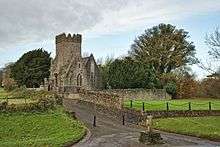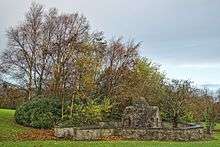St Doulagh's Church
St Doulagh's Church (Irish: Clochar Dúiligh) is one of two churches in the "United Parishes of Malahide, Portmarnock and St Doulagh's" in Fingal, Ireland. It is the oldest stone-roofed church still in use in Ireland.[1] The church is situated approximately 10 kilometres from Dublin city, just north of the hamlet of Balgriffin. Its complex also comprises a stone pool-house and an octagnal baptistry - Ireland's only surviving standalone baptistry.

History and status
The oldest part of the church as it stands is medieval dating from the 12th century, and believed to have been home to a small monastic settlement. However, according to studies on the site, Christian activity here dates back to the time of St. Patrick. Following the English Reformation, the church and its assets came into the control of the Established church. The majority Roman Catholic population was obliged to conduct its services elsewhere in private accommodations. Since 1974, the church of the "Holy Trinity" has served the Roman Catholic parishioners of Donaghmede, Clongriffin and Balgriffin.[2]
There was a regular "pattern" held at the church until at least the 18th century.
The Church is once thought to have been linked to Grange Abbey and "The Grange" House of Baldoyle through an underground passageway.
The buildings
The main historic building is 48 feet by 18 feet, with a double roof of rough stone set with cement. The space between the inner and outer, wedge-style, roof is usable. Partway along the roof is a small stone tower. There is a small door on the south face, with a rough arch, and traces of smoother arches on either side. Inside are a smaller room, with the reputed tomb of St Doulagh, and a larger room, the former main place of worship, with a stairway to the upper floor and tower.
Along the stairway is the Prior's chamber, then the area where the clergy ate and slept.
A modern church was added in 1864, and consecrated in 1865.

Aside from the main church building, St Doulagh's features, in the field beyond the church, nearer the road, a low octagonal building, covering a spring, which was probably used as a baptismal font, feeding also an open-air pool with stone seating, all these in a sunken stone enclosure. Linked to this enclosure by a water channel is a stone pool-house, with a body of water called St Catherine's Pond.
The octagonal building is believed to have been a baptistry, the only surviving detached baptistry in Ireland, and the pool alongside may have been used for adult immersion.
The baptistry was repaired and supplied with fresco paintings of St Patrick, St Doulagh, St Bridget and St Columcille, and others, by a resident of the vanished village of Feltrim, in 1609. The frescos were damaged by soldiers of Sir Richard Bulkeley of Dunlavin after the Battle of the Boyne.
There is also a cross, of non-local granite, at the entrance.
Restoration
The complex was cleaned and the baptistry complex in particular restored in 1991, although the Victorian church element was not a main focus of the work, which was State-funded.
St Doulagh
Very little is known of St Doulagh (Irish: Naomh Dúileach) who gave his name to the church. It is calculated that he lived in the early 7th century and was a hermit/anchorite. He is said to have lived isolated, in a cell attached to the church, and to have had only minimal contact with the outside world. Anchoritism was a feature of the Celtic church and one of many interesting points of similarity between Ireland's early Christianity and the Eastern churches.
In the 19th century there was some dispute over the existence of St Doulagh some thinking that he was in fact the 10th century Viking god, Olave. However it is now known that he did exist. It was also thought that the actual church may have been built by Vikings but again it was proved due to the methods of construction that the Irish built it; the features of the church were not those of Viking structures.
The feast day of St Doulagh is November 17.
References
- ↑ "St. Doulagh's Church". Megalithic Ireland. Retrieved 30 November 2015.
- ↑ Holy Trinity Parish (Roman Catholic).
| Wikimedia Commons has media related to St. Doulagh. |
Coordinates: 53°24′53″N 6°10′42″W / 53.41472°N 6.17833°W